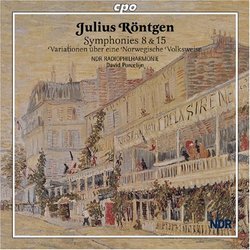| All Artists: Julius Rontgen, David Porcelijn, Hamburg North German Radio Symphony Orchestra, Carmen Fugiss Title: Julius Röntgen: Symphonies 8 & 15 Members Wishing: 0 Total Copies: 0 Label: Cpo Records Original Release Date: 1/1/2009 Re-Release Date: 9/29/2009 Genre: Classical Style: Symphonies Number of Discs: 1 SwapaCD Credits: 1 UPCs: 761203730728, 761203730728 |
Search - Julius Rontgen, David Porcelijn, Hamburg North German Radio Symphony Orchestra :: Julius Röntgen: Symphonies 8 & 15
 | Julius Rontgen, David Porcelijn, Hamburg North German Radio Symphony Orchestra Julius Röntgen: Symphonies 8 & 15 Genre: Classical |
Larger Image |
CD Details |
CD ReviewsThe Marvelous cpo Röntgen Series Continues J Scott Morrison | Middlebury VT, USA | 11/05/2009 (5 out of 5 stars) "One of the best aspects of cpo's investigation of the riches of late 19th-century and early 20th-century Romantic orchestral music is its ongoing series of recordings of the symphonies of Julius Röntgen (1865-1932), a Leipzig-born composer long resident in the Netherlands. Röntgen's two greatest influences were Brahms and Grieg. He knew both composers, and indeed was on very close terms with Grieg for many years, often trading visits back and forth between Amsterdam and Troldhaugen.
The Eighth Symphony (1930) is a 18-minute one-movement work with wordless soprano vocalise in alt. It is lightly scored and although its demeanor is rather serious, its means are almost impressionistic, seeming to float at times in an ethereal world of its own. One pictures early morning mists or wispy wanly-lit clouds at twilight in the Jotunheim district of Norway, an area where Röntgen and Grieg had hiked. (There is also a gorgeous 'Jotunheim Suite', recorded earlier: Julius Röntgen: Symphony No. 3; Suite "Aus Jotunheim"). The formidable pianissimo soprano part is handled with aplomb by Carmen Fuggiss. The Fifteenth Symphony (1931) is an altogether more dramatic affair. In the usual four movements lasting twenty five minutes, the first and last movements are almost Brahmsian in their use of classical procedures with frequent fugatos and canons. The second features an insistent fluttering from the solo flute and later the bassoon, and the third (lento) gives its main attention to doleful solos by the principal cello. The dramatic fourth has its lyrical moments but ends with dramatic tutti chords separated by silences, reminiscent of the ending of the Sibelius Fifth Symphony. 'Variations on a Norwegian Folk Melody' is a twenty-five minute homage to the Röntgen/Grieg friendship. It is based on a folksong, 'Det er den störste darlighet' ('It is the greatest foolishness'), that Grieg had included in his Nineteen Norwegian Folk Melodies, Op. 66. It is one of those melodies that immediately imprint themselves in one's mind. Röntgen originally wrote the Variations for solo piano in 1896, but in 1932, after having just published a biography of Grieg, he came back to it and arranged it for orchestra. (He also made an arrangement then for two pianos.) It begins with a plain statement of the melody in essentially Grieg's harmonization. Then follow a series of variations and a grand summing-up finale. Although the tune reminds one of Grieg, the variations themselves are Brahmsian. The whole, except for the finale, is rather gently lyrical and completely winning. This is a piece worthy of inclusion, at least occasionally, in the world's concert programs. Conductor David Porcelijn and the NDR Radiophilharmonie have done themselves and the music of Röntgen proud. I have yet to play this or other Röntgen music for listeners without them responding with enthusiasm. Other recordings in this series: Rontgen: Symphony No. 18 in A, Julius Röntgen: Symphonietta humoristica, Julius Röntgen: Aus Goethes Faust. Heartily recommended. Scott Morrison " |
